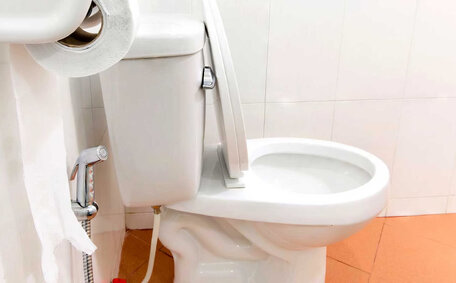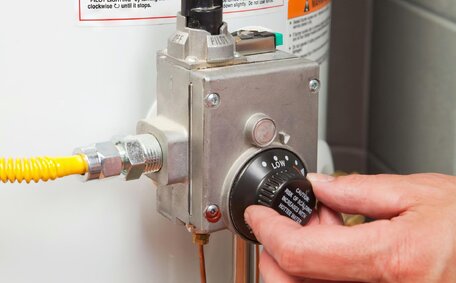Introduction to Noisy Toilet Flushing Issues
A noisy toilet during flushing — characterised by gurgling, hissing, or foghorn sounds — typically indicates an underlying issue.
Common causes of toilet noise include:
- A misadjusted or faulty fill valve can cause disruptive noise immediately after flushing.
- A worn out flapper valve seal resulting in your toilet making noise as water leaks into tank
- Debris or sediment interfering with the flushing mechanism can cause noise.
- Issues with the water supply like high pressure or water hammer
The good news is that most noisy toilet problems can be resolved fairly easily if caught early after flush. Effective troubleshooting helps determine whether you need a simple fix or professional assistance for part replacement.
Examining issues methodically on your own, including the ballcock valve and other components of your toilet’s flushing system, can help mitigate noise when use and restore a quieter flush. A professional plumber can diagnose and address ongoing flushing noises.
What Causes a Toilet to be Noisy When Flushing
Fill Valve Issues
Fill valve issues, responsible for refilling the tank post-flush, are a principal cause of noise. A worn or faulty fill valve may fail to close properly, causing continuous water flow into the tank and resulting in a noisy, running toilet. Malfunctioning fill valves may produce gurgling or hissing noises post-flush.
A poorly adjusted float switch, obstructed fill valve, or incorrectly installed toilet flapper can also lead to similar noisy symptoms when flushing by disrupting the refill process.
Flapper Valve Problems
Issues with the flapper valve at the bottom of your toilet tank are another prime suspect that cause water inefficiencies. A flapper past its usable lifespan can cause your toilet bowl to become misshapen, inflexible, or develop cracks allowing water to continuously leak from the tank into bowl, even when the toilet hasn’t been flushed recently.
A faulty flapper can result in phantom flushing sounds and increased water bills. Replacing an old, faulty flapper with a new seal can easily fix this.
Debris or Buildup
Debris, sediment, or mineral deposits around internal components involved in the flush mechanism can obstruct water flow and cause turbulence or spraying noises when operating the toilet. Calcium and rust buildup are common toilet tank contaminants.
Carefully examining parts like the inlet valve and other toilet connections for anything unusual, then cleaning or replacing affected pieces, can clear up unwanted sounds that may cause your toilet to act up.
Water Pressure Issues
High water pressure through supply lines can lead to loud noises when flushing the toilet or during the water heater refill. Installing a water pressure reducer, adjusting the main water valve of your home, or using a hammer arrestor device can help regulate the flow and reduce the sound after flushing.
Fill Valve Problems Causing Noise
The reasons why your toilet makes noise when flushing or refilling often boil down to an issue with the fill valve. This small but important toilet component is responsible for refilling the tank with the correct amount of water when water is required after you flush the toilet, preventing it from making noise.
Fill valve issues may manifest as loud hissing or gurgling noises in your toilet. This can indicate water isn’t shutting off appropriately and is one of the reasons why your toilet is causing noise after spilling into the overflow pipe because the valve fails to close completely.
What Causes Fill Valve Noises
There are a few specific problems that can lead to a noisy fill valve:
- A damaged fill valve seal that permits water leakage
- An incorrectly adjusted float arm
- A fill valve installed too high in the tank
- Sediment buildup interfering with operation
- A fill valve that fails to close correctly
Assessing the fill valve to determine the underlying problem is the first step. From there, remedies may involve wiping away mineral deposits, adjusting the float arm, or replacing fill valve parts.
When to Call a Professional Plumber
Finding the best way to repair a noisy fill valve is often an easy DIY project. However, for old valves needing replacement, it’s advisable to contact Colyton Plumbing. Our licenced, experienced technicians can expertly diagnose issues and install a new fill valve tailored to your toilet model for optimal performance.
Flapper Issues Leading to Noisy Flushing
The flapper, located at the tank’s base, is crucial for sealing water until flushing. Over time, this rubber part can become misshapen, inflexible, or develop cracks that compromise its seal.
A deteriorated, improperly seated, or otherwise faulty flapper allows water to continuously leak from the tank down into the bowl. This can cause phantom flushing sounds and, consequently, higher water bills.
Replacing an Old Flapper
A hardened, warped, or cracked flapper often fails to seal the tank effectively upon flushing. These toilet cistern components wear out and typically need replace every 3-5 years.
Swapping out an old, damaged flapper with a new one matching your toilet model can easily fix related noisy operation. DIY flapper replacement is straightforward - simply detach the old one, clean sealing surfaces thoroughly, including the vent stack, then install and adjust the new flapper.
When to Call a Plumber
However, if replacing the flapper and checking other parts doesn’t solve the common problem of a noisy toilet, contact our Colyton Plumbing experts. We have the tools and know-how to diagnose and remedy trickier causes of a loud, disruptive toilet flush.
How to Diagnose the Source of the Toilet Noise
Pinpointing the origin of a noisy toilet flush requires methodically troubleshooting several components to isolate the problem.
Turn Off Water Supply
Begin by turning off the toilet’s water supply valve. This allows you to use your flush mechanism without water flow so you can listen closely to any strange noises indicating problems.
Examine Toilet Tank
With the tank lid removed, thoroughly inspect the various mechanical parts inside the tank, focusing on potential issues that arise when use. Check for issues like debris buildup, leaks, damage, misalignment, improper adjustment, or wear. Activate the trip lever to simulate a flush and identify any noises.
Assess Common Culprits
Examine parts such as the flapper, fill valve, overflow tube, and connections closely. Determine if sediment or water pressure is potentially contributing to noise.
When to Call a Professional
If you’re perplexed by the question 'why my toilet is producing peculiar noises?', and unable to diagnose the origin of the noise through examination and troubleshooting, contact our licenced technicians at Colyton Plumbing. We have specialised equipment to identify issues not visible to the naked eye and can remedy toilet noises.
Step-by-Step Instructions to Fix a Noisy Toilet Flush
If your toilet makes noise during flushing, you can undertake some DIY troubleshooting steps before resorting to a plumber:
1. Turn Off Water Supply
Start by locating the water supply valve near the toilet and turning it clockwise to close it.
2. Check Flapper Chain
Check that the chain connecting the flapper valve inside the tank is properly adjusted (about 1/2 inch of slack). Reconnect or adjust as needed.
3. Clean Fill Valve
Remove any dirt, debris or mineral buildup from the toilet fill valve and float cup. Ensure the fill valve is installed at the correct height in the tank.
4. Check Water Level
Adjust the water level to align with the tank’s marked water line. Adjust the float cup height up or down if required.
If noises persist after these steps, seek professional diagnosis and repair from Colyton Plumbing. We can identify and fix any underlying issues to restore your toilet’s quiet operation.
Adjusting the Flapper Chain and Replacing Flapper
The flapper chain connects the flapper valve inside the toilet tank to the flush handle and trip lever. Proper adjustment, with about 1/2 inch of slack, allows the chain to function smoothly without getting detached.
If the flapper chain is too tight, loose, or disconnected, it can lead to a poor seal and cause a noisy, inefficient flush. Shortening an excessively long chain or reconnecting a detached chain can help get rid of this issue.
When to Replace the Flapper
Beyond chain issues, inspect the condition of the flapper itself, which seals water in the tank. Cracks, stiffness, warping, and corrosion mean it’s time to replace the flapper.
Flappers wear out approximately every 3-5 years. Swapping in a new, properly sized flapper matched to your toilet model creates an improved seal and can eliminate noises that sound like phantom flushing.
Contact Colyton Plumbing for assistance with adjusting or replacing toilet components. We can ensure optimal function and noise reduction.
Cleaning and Adjusting the Fill Valve
A noisy fill valve that hisses or gurgles during refilling can often be remedied by thoroughly cleaning the valve and float cup assembly. This removes any built-up sediment or mineral deposits that may be interfering with proper operation.
How to Clean the Fill Valve
Follow these steps to clean the toilet water path:
- Turn off the water supply for your toilet.
- Flush the toilet to empty water from the tank.
- Disconnect the water supply line from the bottom of the fill valve.
- Unscrew the fill valve from the tank.
- Use a scrub brush and white vinegar or lime scale remover to clean off debris.
- Rinse thoroughly.
- Reinstall the fill valve at the correct height in the tank.
Adjusting the Fill Valve
If hissing continues, the water level may need adjusted. Turn the adjustment screw atop the fill valve toilet component to raise or lower the float cup. The water level should be around 1/2 inch below the tank refill tube opening when full.
Adjusting a malfunctioning fill valve is usually a straightforward DIY task for restoring a quiet flush. However, if replacing parts is needed, Colyton Plumbing’s experts can perform a reliable installation.
Maintenance Tips to Prevent Future Noisy Flushing Issues
Preventing noisy toilet flushing issues from recurring involves maintaining your toilet and your plumbing system through simple proactive measures.
Install a Water Hammer Arrestor
Loud banging noises when flushing are often due to high water pressure causing your pipes to rapidly vibrate or "hammer". Installing a water hammer arrestor device can effectively absorb these pressure surges and reduce noise.
Check Water Levels Regularly
Every few months, check that the water level inside the toilet tank is set appropriately when flush to the water line mark. An overflowing tank can generate noise and you should be able to identify this waste in your water supply.
Replace Parts Proactively
Be proactive about replacing ageing toilet parts like the flapper every 3-5 years and fill valve every 5-7 years to prevent wear issues and noise down the track.
Enlist Professional Assistance
For optimal toilet function and noise resolution, Colyton Plumbing provides professional cleaning and adjustment services. We also provide maintenance plans to avert expensive emergencies.
When to Call a Professional Plumber for Noisy Toilet Issues
If you’re pondering 'What can I do to cause your noisy toilet issues to dissipate?', keep in mind that DIY troubleshooting can resolve many of them, but if basic adjustments and part replacements don’t eliminate the bothersome sounds, it’s wise to call in a professional plumber.
Colyton Plumbing’s licensed experts possess the skills and tools to diagnose and resolve complex toilet issues beyond the average homeowner’s capacity. We determine underlying issues through methodical checks, advanced leak detection methods, pressure testing, valve assessments and more.
Call Us for Persistent Noisy Toilet Flushing If:
- Persistent noises after cleaning or replacing components like flappers and fill valves
- Flush operation seems abnormal despite adjustments
- You have an older toilet nearing the end of its lifespan
- There are other plumbing faults indicating system issues
With over 25 years of experience in the Colyton area, we understand how local water conditions can affect your plumbing system’s noise levels. Learn more about our 24/7 emergency assistance for plumbing issues if your noisy toilet is causing disruptions.
For immediate assistance from qualified technicians ready to fix troublesome toilet noises, contact us via email, schedule an appointment, or reach out to Colyton Plumbing at 1300 349 338.






